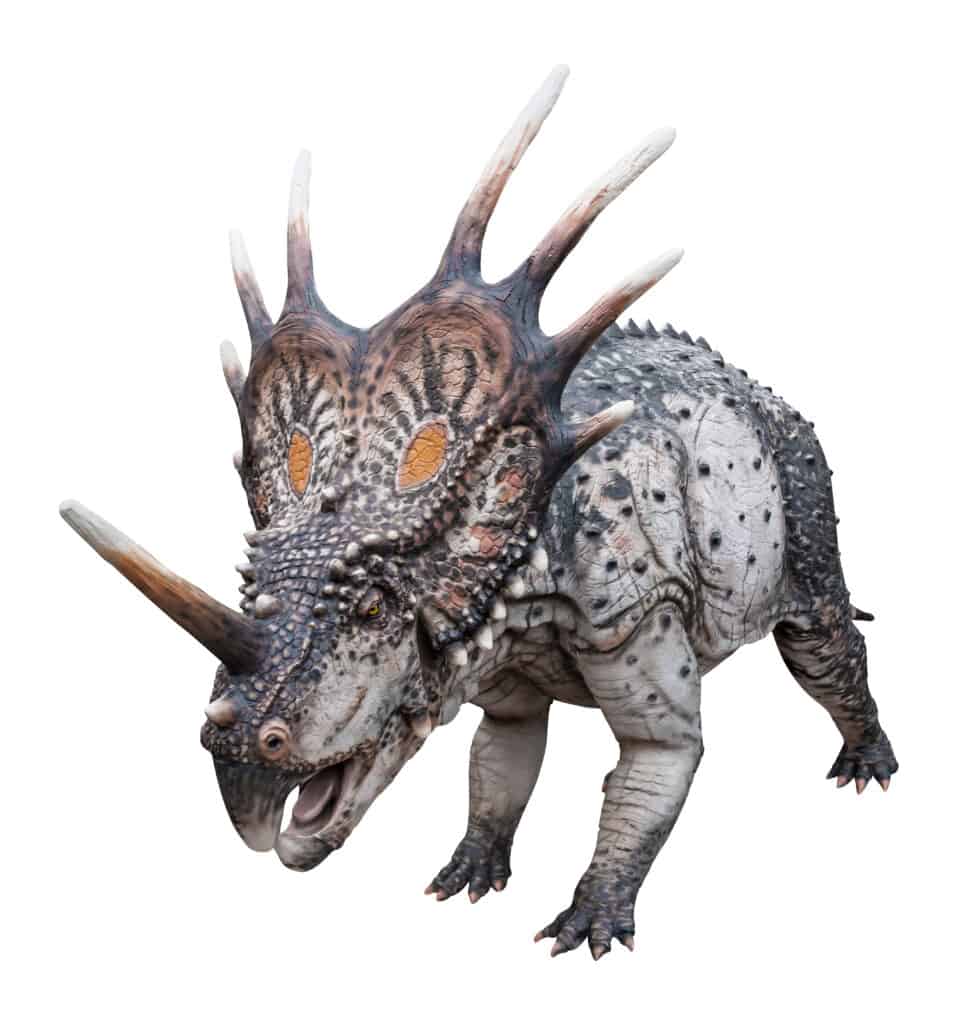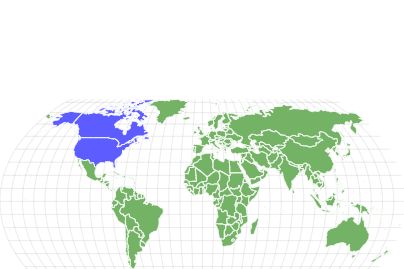Styracosaurus
Styracosaurus
Advertisement
Styracosaurus Scientific Classification
- Kingdom
- Animalia
- Phylum
- Chordata
- Class
- Reptilia
- Order
- Ornithischia
- Family
- Ceratopsidae
- Genus
- Styracosaurus
- Scientific Name
- Styracosaurus
Read our Complete Guide to Classification of Animals.
Styracosaurus Conservation Status
Styracosaurus Facts
- Prey
- Ferns, palm, cycads
- Name Of Young
- hatchling
- Group Behavior
- Social
- Group
- Sociable
- Biggest Threat
- Gorgosaurus libratus, Daspletosaurus torossus
- Most Distinctive Feature
- One nose horn, nose frill with 4-6 horns
- Gestation Period
- 3-6 months
- Habitat
- Plains and forests
- Predators
- Gorgosaurus libratus, Daspletosaurus torossus
- Diet
- Herbivore
- Lifestyle
- Group
- Sociable
- Type
- Reptile
- Common Name
- Styracosaurus
- Number Of Species
- 2
- Location
- Canada, USA
View all of the Styracosaurus images!
Description & Size
Styracosaurus is a genus that translates into a spiked lizard. It was found in the year 1913 and currently only has two known species; the Styracosaurus albertensis and Styracosaurus ovatus.
From the study of fossils, the paleontologists were able to gather the following facts regarding their physical attributes:
- The size of the Styracosaurus stood around 5.9 ft tall, which is slightly more than a human adult, and was around 18 ft long.
- It had a neck frill with at least 4 large spikes and a nose horn all of which were usually around the same size. (20-22 In.)
- Despite not being as bulky as other dinosaurs, the Styracosaurus had a relatively heavier body, weighing around 3 to 5 tons. It was built like a modern-day rhinoceros or elephant.
- It had a lightish brown body with green spots and possibly an orange-colored neck frill.
- It was a four-legged organism whose rear legs were shorter than its front legs.
- It had quite a huge skull with an even bigger neck frill surrounding its head. The neck frill is an important characteristic of this dinosaur as it had three frills and was different from other dinosaurs.
- A distinctive feature of the Styracosaurus is its horns. Six large horns came out of the neck frill, one large and pointy horn came out of its nasal area, and two shorter horns protruded out of its cheeks.
- The strong jaw and teeth combination was another distinct feature of this dinosaur. Its teeth were flat and beak-like which created a tougher dental strength for the Styracosaurus.
- It was also known to carry cheek pouches to store the food while it chewed on the thick plants.
- The tail of the Styracosaurus was quite short and had small feet that resembled hoofs.

The Styracosaurus had a distinct horn protruding from its nasal bone.
©YuRi Photolife/Shutterstock.com
Diet – What Did Styracosaurus Eat?
The Styracosaurus was an herbivore. It was not as large as the other plant-eating dinosaurs around that era, but it had quite powerful teeth.
Because the structure of its teeth was flat and beak-shaped, it is safe to assume this dinosaur was a plant-eater.
Since it was short, it could not reach the higher plants, but the tough teeth and the strong horns made up for this. They had the power to break down the strong plants through their horns and gobble up the thicker plants for easy digestion. In addition, they could comfortably ingest wooden vegetation which may have been difficult for other plant-eaters.
The typical diet of this dinosaur is thought to be ferns, cycads, and palms, but it is assumed to have a broader range of preferences for plants than other herbivores. Some paleontologists even think that it swallowed smaller stones to help in grinding the thick plant diet of the Styracosaurus.
Habitat – When and Where It Lived?
The Styracosaurus lived in the Cretaceous period of the Mesozoic era. They existed around 75 million years ago in what is now Canada and around Utah and Arizona in the USA.
Considering the diet and body of the Styracosaurus, it was predicted to have lived in forests with thick vegetation. Some common assumptions are that there were ferns and palms around or near the dinosaurs which were consumed for energy.
Behavior
The Styracosaurus is assumed to be quite a sociable and peaceful dinosaur. It usually grouped itself into a small herd of 3 to 5 Styracosaurus, which is suggested due to the evidence found in its fossils. There have been bone beds found with multiple Styracosaurus fossils.
Moreover, the idea that they traveled in groups makes sense for their protection, as they were one of the shorter herbivores. Even with the horns, defense from large predators was likely a challenge for the Styracosaurus.
Threats And Predators
The Styracosaurus lived amongst many different kinds of species. Most of them were herbivores but were quite larger than this average-sized dinosaur.
The only known carnivores that are considered to have been a possible threat to the Styracosaurus are the Tyrannosaurus, Albertosaurus, Gorgosaurus libratus, and Daspletosaurus torossus.
The Styracosaurus was also capable of living comfortably alongside many smaller carnivores like the Deinonychus and Dilophosaurus. A group of paleontologists believes that the horns were used as a form of weapon because they could easily pierce the rival opponent like a modern-day rhino.
Discoveries And Fossils – Where It Was Found
The first fossil of the Styracosaurus was found in the year 1913 in Alberta, Canada. The two known species of the Styracosaurus are the Styracosaurus albertensis and Styracosaurus ovatus.
The Styracosaurus albertensis was found first in 1913 while the Styracosaurus ovatus was found in the year 1930. The tip of the Styracosaurus’ nose horn has still not been discovered but has been compared with other dinosaur fossils and is assumed to have been pointed.
In 1915, the first complete skeleton of the Styracosaurus was examined. In the same year in the U.S., there were 100 Styracosaurus fossils found in Arizona which suggest that they lived and moved in herds.
It was also thought that they might have traveled for water and died at the same place due to drought, but the theory that they were sociable dinosaurs seems to prevail.
In 1935, large portions of the skeleton of the Styracosaurus were discovered, leading to a detailed description of its physical attributes.
Extinction – When Did It Die Out?
The exact cause of extinction is yet to be found. However, when this period ended, an asteroid hit the Earth and wiped off more than half of the animal population. Because the Styracosaurus lived during this era, this is a likely reason for their extinction. Aside from that, there were terrible natural conditions at that time including drought and deforestation. So, that may have been one reason for this dinosaur to eventually become extinct.
Similar Animals to The Styracosaurus
- Rhinoceros – an animal with a body and a nose horn similar to the Styracosaurus. It is also a herbivore.
- Elephant – an herbivorous animal whose body resembles that of the Styracosaurus with its short tail and hoofed feet.
- Triceratops – a dinosaur that is similar to the Styracosaurus, but it had three horns instead of the one on its nasal bone.
Styracosaurus FAQs (Frequently Asked Questions)
Are Triceratops and Styracosaurus related?
Yes, they are distantly related.
What does the name Styracosaurus mean?
The term Styracosaurus translates into a spiked lizard.
What dinosaur has 15 horns?
The Kosmoceratops richardsoni had 15 horns and 10 of them were on its nose frill.
Thank you for reading! Have some feedback for us? Contact the AZ Animals editorial team.
Sources
- Wikipedia, Available here: https://en.wikipedia.org/wiki/Styracosaurus
- Prehistoric Wildlife, Available here: http://www.prehistoric-wildlife.com/species/s/styracosaurus.html
- Extinct Animals, Available here: https://www.extinctanimals.org/styracosaurus.htm
- Prehistoric Wildlife, Available here: http://www.prehistoric-wildlife.com/species/s/styracosaurus.html
- Smithsonian Mag, Available here: https://www.smithsonianmag.com/science-nature/the-last-styracosaurus-standing-113182646/
- Thoughtco, Available here: https://www.thoughtco.com/things-to-know-styracosaurus-1093800

















